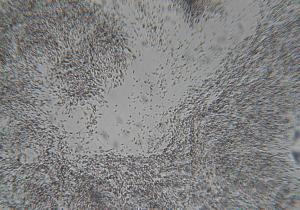– The Accumulator Stallion
By Jamie Anderson, MA Physiol (Oxon)
 Spermiostasis, also known as blocked or “plugged” ampullae is a condition that occurs in up to 25% of sexually rested stallion.
Spermiostasis, also known as blocked or “plugged” ampullae is a condition that occurs in up to 25% of sexually rested stallion.
In normal circumstances, a stallion is producing between 30,000 and 70,000 sperm every second. Obviously if these sperm are not being removed through ejaculation, they must be removed by another method. Normally they are removed during urination, by contractions of the terminal portion of the deferent duct called the ampulla. The ampulla is a widening of the deferent duct, and is surrounded by smooth muscle which contracts to push sperm cells towards the urethra for ejaculation, or to remove older sperm cells from the ducts.
Stallions suffering with spermiostasis are unable to emit these sperm cells without ejaculating, and therefore accumulate sperm cells in the epididymis and deferent ducts, especially in the ampullae. The retained sperm begin to degenerate, and may become so packed together that the ampullae will become blocked; literally plugged with a solid mass of degenerating sperm.
When looking at a semen sample collected from one of these stallions; typically one will see an unusually high sperm concentration (650 to 1500 million sperm per ml), high total sperm numbers, and a high percentage of detached heads (perhaps 50% or more). Sometimes the ejaculated sperm will form clumps (see photo), and one may see “pellets” of degenerating sperm in the collection bottle filter.
The good news is that spermiostasis can be treated with management alterations. Initially, serial collections are recommended (perhaps daily or twice daily), which will usually result in improved ejaculate quality after 5 to 10 collections. Some stallions with particularly badly blocked ampullae may require 15-25 collections before an improvement is seen. The problem is an ongoing one, and it is therefore necessary to carry on collecting semen from these stallions throughout the breeding period at the rate of 3-5 times per week. If regular collections are not performed then relapse is likely.
Rectal massage of the ampullae, or treatment with oxytocin or prostaglandin immediately prior to collection may also be of assistance in “unblocking” the ampullae.
In naturally serving stallions retrospective analysis of breeding records may aid in the diagnosis of spermiostasis. Usually the first 5-10 mares of the season do not become pregnant, with normal pregnancy rates occurring for subsequent mares.
Spermiostasis is not a condition which is limited to older stallions, although occurrence in the aging population is more frequent than in younger animals. It is a condition that, with the correct management, should not have a detrimental effect the stallion’s fertility or ability to breed in the vast majority of cases.
© 2012, Equine-Reproduction.com LLC
Use of article permitted only upon receipt of required permission and with necessary accreditation.
Please contact us for further details of article use requirements. Other conditions may apply.


